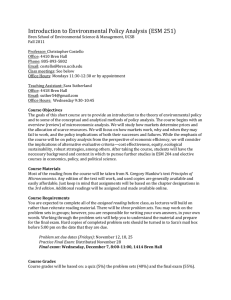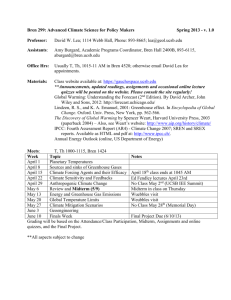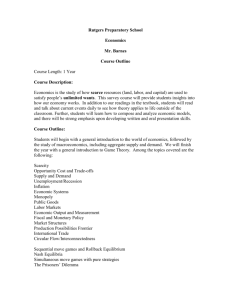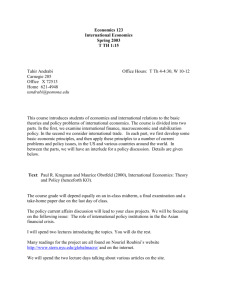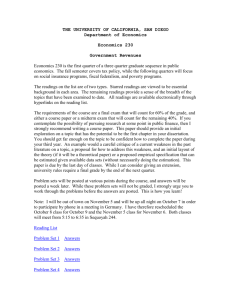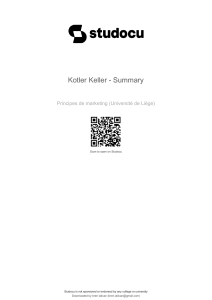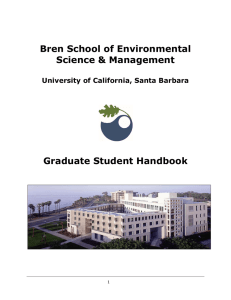Welcome to ESM 204: The Economics of Environmental Management
advertisement
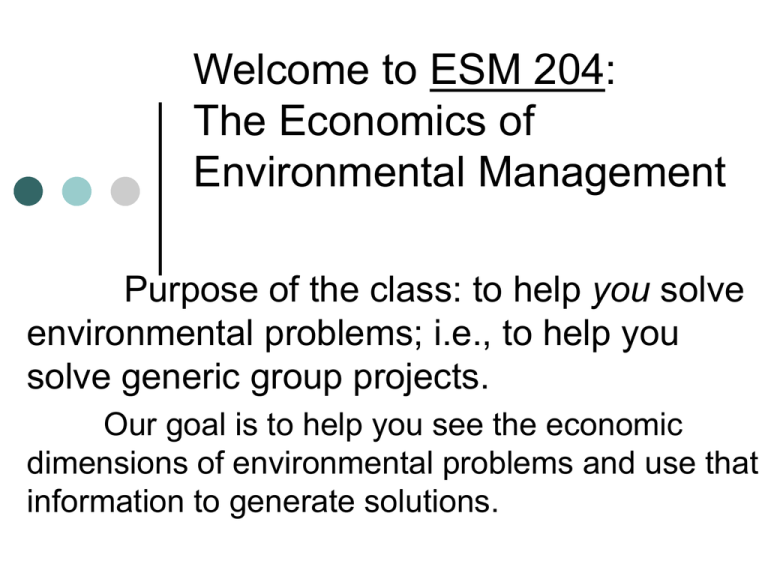
Welcome to ESM 204: The Economics of Environmental Management Purpose of the class: to help you solve environmental problems; i.e., to help you solve generic group projects. Our goal is to help you see the economic dimensions of environmental problems and use that information to generate solutions. Staff Prof. Christopher Costello: Marc Conte, TA: 4410 Bren Hall, 893-5802, costello@bren Office Hours: Monday/Tuesday 8:30-9:30 3424 Bren Hall, mconte@bren Office Hours: Tuesday/Wednesday 2:00-3:00 PhD student in Bren Plan to attend office hours! We want to get to know you! Course Vitals Prerequisites: Calculus & ESM 251 or Econ 100AB 20 lectures, Tuesday & Thursday, 11:00-12:15 1 discussion section per week, run by Marc You should be familiar with Excel & SOLVER You are expected to attend all lectures and 1 discussion per week. Workload: Above average. Expect 8-10 hours per week outside of class, on average. Grading Homework Assignments .. 40% 5-6 “mini-group-projects”: may/should work with a partner, submit 1 copy with both names Late assignments will not be accepted May not use the same partner twice (i.e., keep moving!). Work should be your own!. Do not share outside your team! Class/section participation .. 10% Midterm..20% Take Home – Distributed Feb 13, Due Feb 15 Final Exam..30% March 22, 12:00-3:00, MSI building Cheating/plagiarism will not be tolerated. Readings & Preparation Readings: available as a reader @ Grafikart Some also available on web Several books will be used a lot Recommended only though you may wish to buy • Hartwick and Olewiler: The Economics of Natural Resource Use, 2nd Edition (Addison-Wesley, 1998) • Boardman et al: Cost-Benefit Analysis, 2nd Ed (Prentice-Hall, 2001) • Kolstad: Environmental Economics (Oxford, 2000) Lower level book: Goodstein Preparation Please come to class prepared. Preparation: read the assignments listed for the day on the webpage. I will call on you in class. Please help make this an interactive experience. Questions?? Course Approach VERY hands-on Every lecture designed to help solve a generic group project. Lecture Style Begin with brief overview from last class + questions. Motivate new material. • I will always motivate material with a hypothetical group project • If I can’t think of a good use for the material in a real-world, groupproject-like setting, you should not bother learning it. Cover new material; ask about readings Open discussion throughout. What will we cover? Course broken into 4 sections: 1. 2. 3. 4. Project Evaluation: Evaluating public environmental projects and regulations (5) Measuring benefits and costs (3) Environmental Regulation (6) Managing renewable and non-renewable resources (5) Section 1: Evaluating Projects and Regulations 1. 2. 3. 4. 5. Cost effectiveness vs. cost/benefit, public goods, externalities Applications: cost-effectiveness, cost-benefit, multi-objective methods Efficiency & surplus; doing benefit-cost analysis; equity vs. efficiency Inflation & discounting Risk & uncertainty Section 2: Measuring benefits and costs 1. 2. 3. Costs of regulation and the “benefits transfer” approach; travel cost Revealed preference approaches Stated preference approaches; constructed markets; experiments. Section 3: Environmental Regulation 1. 2. 3. 4. 5. 6. Regulatory options and efficiency. Innovative approaches to regulation Incidence of environmental regulations. Spatial and temporal dimensions of environmental regulations. Monitoring and enforcement. Regulatory experience in developed vs. developing countries, green accounting. Section 4: Managing renewable & non-renewable resources 1. 2. 3. 4. 5. Rent, water, and common property. Fishery economics. Managing the fishery. Forest economics & management. Non-renewable resources and energy.
